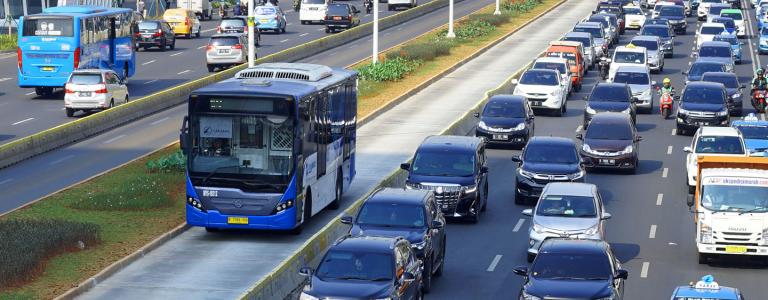Using Systemic Approaches and Simulation to Support Transformation Toward Sustainable Mobility
Transport is a crucial part of modern society, connecting communities and fostering development. However, the impact of the transport sector on the planet is huge, causing over 20% of global carbon dioxide emissions. It is therefore one of the main drivers of climate change while also having significant direct and indirect negative impacts on human health. This project aims to drive investment towards sustainable mobility and transport.
As populations and cities grow, the world’s transport networks will need to expand and modernize to meet demands. Sustainable transport can provide safe, accessible, efficient, and resilient mobility while minimizing carbon dioxide and other emissions. Despite these benefits, sustainable transport infrastructure is not being developed at the scale needed to adapt to ever-increasing climate impacts and to meet net-zero targets by 2050.
All infrastructure investments generate benefits and costs, which is why it is crucial to identify, quantify, and analyze all impacts surrounding a project. We use our Sustainable Asset Valuation (SAVi) methodology, which is rooted in systems thinking and uses tools like spatial, Excel-based, and system dynamic models, to provide a more holistic understanding of the value of sustainable transport infrastructure by weighing the environmental, economic, and social co-benefits of a project. These approaches can be key instruments for helping investors, planners, and policy-makers make informed decisions about sustainable transportation investments.
For this project, we will deploy the SAVi methodology in 9 countries, as well as providing capacity building and training activities for policy makers and decision-makers. The general goals of this project are threefold:
- To review strategic frameworks, methods, and models for sustainable transport.
- To generate evidence of the societal benefits of a variety of projects, considering direct, indirect, and induced social, economic, and environmental project outcomes.
- To inform decision making for upscaling investments in sustainable transport, also in the context of green and resilient recovery packages.
The project will specifically estimate investment avoided costs and added benefits of sustainable transport based on social, economic, and environmental indicators with a view of informing and influencing decision making on project selection, financing strategy, and implementation. It will also focus on the macro-economic level by providing an estimation of the contribution of sustainable transport to national sustainable development, considering its role in strengthening growth and in reducing public and private costs.
This will result in increased knowledge of the benefits of investing in sustainable transport infrastructure, as well as guide decision-makers on why and how to plan, choose, and implement sustainable transport and mobility-related investments.
Our work
A Sustainable Asset Valuation of Non-Motorized Transport in Coimbatore, India
A Sustainable Asset Valuation (SAVi) of the economic, social, and environmental benefits of a non-motorized transport (NMT) network in Coimbatore, India.
A Sustainable Asset Valuation of a Bus Rapid Transit System in Bandung, Indonesia
This report presents the economic valuation of a planned Bus-Rapid Transit system in Bandung, Indonesia, including investment costs, added benefits, and avoided costs.
A Sustainable Asset Valuation of the FAME II policy in India
This report presents the economic valuation of the second phase of the Faster Adoption and Manufacturing of Electric (& Hybrid) Vehicles (FAME II) policy in India and demonstrates its economic, social, and environmental outcomes under different scenarios.
A Sustainable Asset Valuation of a Net-Zero Transport Strategy in Indonesia
This report presents the economic valuation of net-zero transport strategies in Indonesia—their investment costs, added benefits, and avoided costs—encompassing interventions such as investments in public transport, private vehicle electrification, teleworking, and decarbonization of the electricity supply.
Valuing Sustainable Transport
All infrastructure investments generate benefits and costs, which is why it is crucial to identify, quantify, and analyze all impacts surrounding a project. IISD developed the Sustainable Asset Valuation (SAVi) method to do just that, helping investors, planners, and policy-makers make informed decisions about sustainable transportation investments. Join us for this webinar series on valuing sustainable transport with SAVi.
A Sustainable Asset Valuation of the Tirana–Durres Railway in Albania
This report presents the economic valuation of the Tirana–Durres railway in Albania, including its investment costs, added benefits, and avoided costs.
A Sustainable Asset Valuation of the Sustainable Transport Strategy in Bogota, Colombia
This report presents an economic valuation of the Sustainable Transport Strategy in Bogota, Colombia, including its investment costs, added benefits, and avoided costs. The strategy includes Bogota's past and future public transport networks such as the Metro Line 1 mass rapid transit (MRT), TransMilenio bus rapid transit (BRT), and non-motorized transportation (NMT) systems in the city.
A Sustainable Asset Valuation of the Mass Rapid Transit System in Bogota, Colombia
This report presents an economic valuation of Metro Line 1 of the Metro de Bogota, a mass rapid transit (MRT) system in Bogota, Colombia, including its investment costs, added benefits, and avoided costs.
Project team

Liesbeth Casier
Lead, Public Procurement and Sustainable Infrastructure and Coordinator of the NBI Global Resource Centre

Andrea Bassi
Senior Associate

Benjamin Simmons
Director, Sustainable Infrastructure

David Uzsoki
Lead, Sustainable Finance

Michail Kapetanakis
Research Analyst

Edoardo Carlucci
Policy Advisor

Nathalia Niño
Associate

Becca Challis
Communications Officer
Latest
You might also be interested in
Sustainable Infrastructure Programme in Asia (SIPA)
SIPA provides countries in Central and Southeast Asia with capacity development and policy advice at different stages of the infrastructure investment cycle.
Valuing Sustainable Transport
All infrastructure investments generate benefits and costs, which is why it is crucial to identify, quantify, and analyze all impacts surrounding a project. IISD developed the Sustainable Asset Valuation (SAVi) method to do just that, helping investors, planners, and policy-makers make informed decisions about sustainable transportation investments. Join us for this webinar series on valuing sustainable transport with SAVi.
Uncovering the Value of Sustainable Transport Investments
Using a case study in Coimbatore, India, IISD demonstrates the importance of recognizing, valuing, and reflecting the full economic, social and environmental benefits and costs of a transport project in infrastructure decision-making.
The Road to Sustainable Transport
Rethinking and revamping transportation in the post-COVID era could address many economic, social, and environmental challenges.

